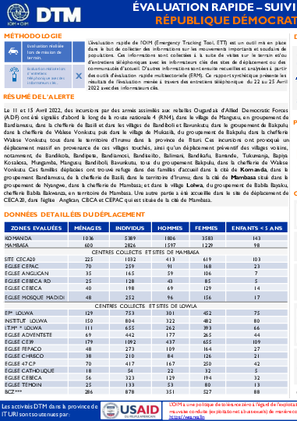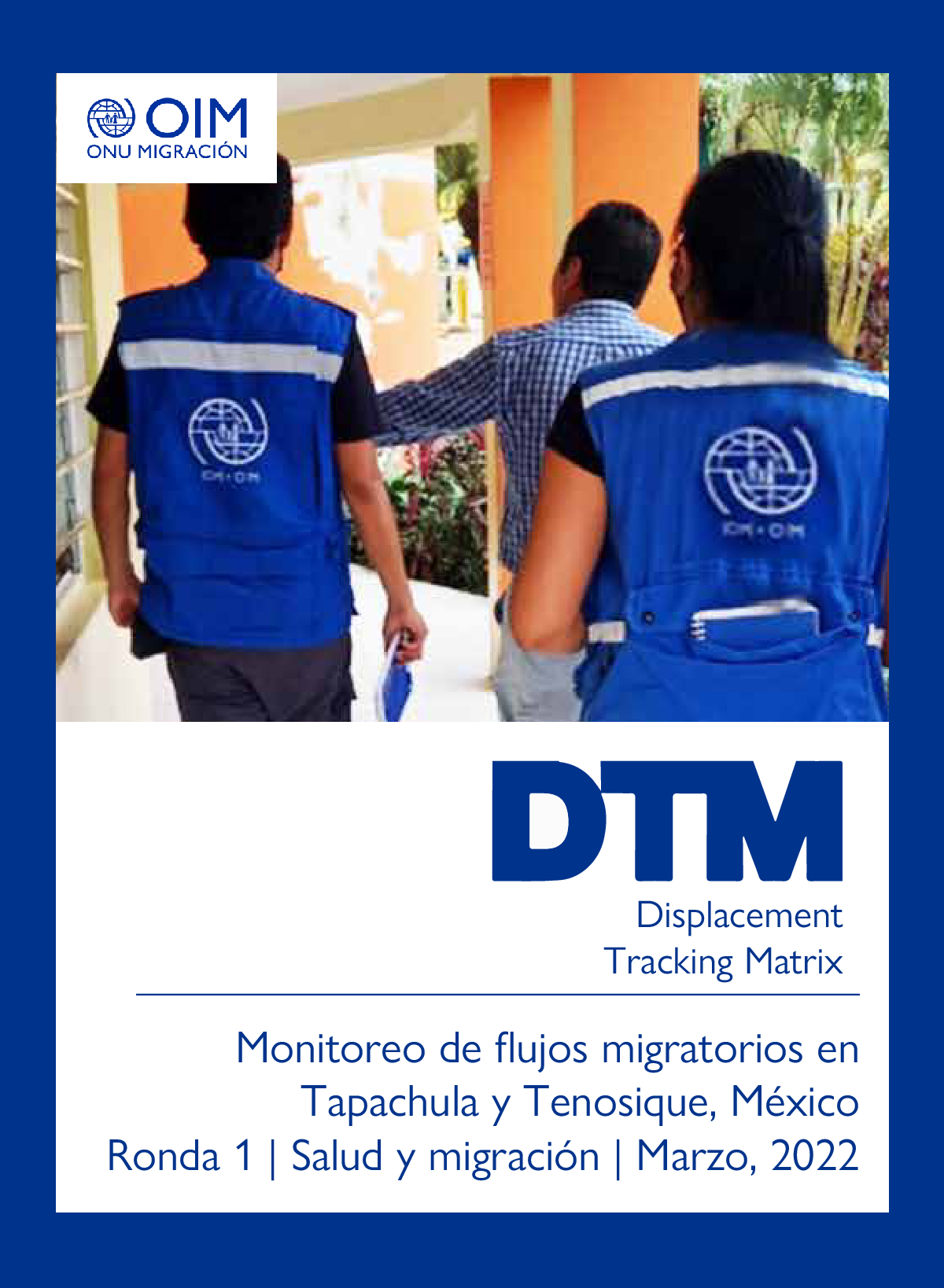-
Countries
-
Data and Analysis
-
Special Focus
-
Crisis Responses
The Horn of Africa and Yemen is one of the busiest and riskiest migration corridors in the world travelled by hundreds of thousands of migrants, the majority of whom travel in an irregular manner, often relying on smugglers to facilitate movement along the Eastern Route. This regional report provides monthly updates on the complex migratory dynamics through Djibouti, Somalia, Yemen and Ethiopia based on diverse data sources and consultations with key informants in the four countries. Moreover, it provides information on the main protection concerns for migrants along the journey, information on the spill over effects of the conflict in Northern Ethiopia observed at the border between Ethiopia, Kenya and Sudan, a specific focus on children and information on the returns from Saudi Arabia to Ethiopia, Somalia and Yemen.

Contact
DTM Ethiopia, SLOAddisAbabaDTM@iom.int
Language
English
Location
Ethiopia
Period Covered
Mar 01 2022
Mar 31 2022
Activity
- Flow Monitoring
In March 2022, a total of 22,029 movements were observed across five of Ethiopia's flow monitoring points (FMPs). This represents a 6% increase in daily average movements in comparison with February 2022 when an average of 667 movements per day were observed. Outgoing movements during March have continued to be higher (83.5%) than incoming movements (16.5%). A total of 18,384 outgoing movements were observed of which 7,728 (42.0%) were heading towards Saudi Arabia, 3,078 (16.7%) were going to Kenya, 2,613 (14.2%) were travelling towards Djibouti, 974 (5.3%) to Sudan, 928 (5.0%) intended to reach the United Arab Emirates, 756 (4.1%) headed to South Africa, and 607 (3.3%) to Somalia while remaining movements were travelling to several Middle Eastern, European and North American countries. At the same time, 3,645 incoming movements were observed, of which 1,069 (29.3%) had originated from Sudan, while 960 (26.3%) came from Djibouti, 908 (24.9%) from Kenya, 511(14.0%) movements from Somalia, and 185 (5.1%) from Yemen. Almost all of these were Ethiopian nationals who were likely returning home.
During the reporting period, while the proportion of migrants who cited 'forced movement due to natural disasters' as the reason for travelling remain very small, it is important to note that the number of migrants citing this as the reason for travel rose by +234% from January (187) to February (623) and by +3% from February to March 2022 (643). Of the 643 migrants who cited 'forced movements due to natural disasters', 95% were crossing the Dawale Flow Monitoring Point and 5% through Moyale. Notably, both points are in the south and east of Ethiopia where the drought is most observable. Dawale FMP saw a steady increase in those travelling from Ethiopia to Djibouti in search of job opportunities, where they cited that they were fleeing the impact of the ongoing drought. In addition, there was an increase in the number of individuals entering Ethiopia from Somalia through the Tog Wochale FMP citing economic reasons for travel. Though drought is not explicitly mentioned, it can be extrapolated that those traveling have likely been impacted by the drought conditions in the country.
Outflows at the Galafi FMP increased this month, and most of those departing reported originating from parts of Amhara region including North Shewa, North Wello and South Wello previously affected by the Northern Ethiopia Crisis. Despite mass returns in the region, especially in these zones, many people are still unable to access sustainable livelihoods and are heading to the middle east to gain access to economic opportunities.

Contact
DTMcovid19@iom.int
Language
English
Location
Global
Period Covered
Apr 25 2022
May 02 2022
Activity
- Other
The DTM Global Mobility Restrictions Overview provides updates on international air travel restrictions and conditions for authorized entry. This overview aims to understand how COVID-19 has impacted human mobility, detailing how global and regional trends in air travel measures have evolved since COVID-19 was declared a global pandemic in March 2020. The data presented focuses on the changes in public health-related immigration and border management measures. It provides information intended to support IOM missions and partners in targeted response planning and advocacy for vulnerable populations who may be affected by changes in global mobility.

Contact
Laura Canché, lcanche@iom.int
Language
English
Location
Mexico
Period Covered
Jan 01 2022
Mar 31 2022
Activity
- Flow Monitoring Survey
- Mobility Tracking
- Event Tracking
Tapachula (Chiapas) and Tenosique (Tabasco) are the main receiving cities for migrants on the southern border of Mexico. 2021 saw record breaking numbers of migrants entering Mexico through the southern border according to the Mexican Commission for Refugee Assistance (COMAR), which reported 89,636 applications for recognition of refugee status in Tapachula and 7,153 applications in Tabasco . However, the National Migration Institute (INM) reported only 19,273 foreigners documented as permanent residents for refugee recognition throughout the country . In parallel, the INM granted 87,174 Visitor Cards for Humanitarian Reasons (TVRH) during 2021, of which 20,364 were issued in Chiapas and 1,499 in Tabasco, mainly for humanitarian causes, offended person, victim or witness of crime, and applicants for refugee status.
Access to health services shows a differentiated behavior between cities because migrants in Tapachula receive care mainly in government health centers while, in Tenosique, NGOs are the main means of accessing medical services. On the other hand, the main obstacles that people who were unable to access medical services in both cities reported facing were lack of information and lack of money.

Contact
DTM Europe, DTMMediterranean@iom.int
Language
English
Location
Romania
Period Covered
Mar 25 2022
Apr 21 2022
Activity
- Survey
Since 24 February 2022, refugees and third-country nationals (TCNs) continue to enter Romania as a result of the war in Ukraine. As of 29 April 2022, Romanian authorities have reported 924,112 arrivals from Ukraine (data via UNHCR and including in the context of those entering from Ukraine via the Republic of Moldova). This report is based on 2,028 interviews conducted by IOM Romania between 25 March and 21 April 2022 in Bucharest, Galați, Iași, Isaccea, Sighetu Marmației, Siret and Suceava.

Contact
DTM Mauritania, DTMMauritania@iom.int
Language
French
Location
Mauritania
Period Covered
Mar 01 2022
Mar 31 2022
Activity
- Survey
- Flow Monitoring Survey
- Flow Monitoring
La transhumance est une pratique de longue date en Mauritanie où elle a évolué au cours des dernières décennies avec la raréfaction des ressources impliquant la redéfinition des routes empruntées par les troupeaux. Par conséquent, des conflits peuvent survenir entre les agriculteurs et les éleveurs transhumants. Dans le cadre du Suivi des Mouvements de Transhumance, l’OIM met en œuvre un système d’alerte qui a pour objectif de recenser les mouvements inattendus de bétail et les conflits ou catastrophes naturelles liés à l’utilisation des ressources naturelles et aux interactions entre agriculteurs et éleveurs, de comprendre les modes de résolution de conflits existants et d’informer les autorités compétentes, dans l’objectif de réduire les tensions dans les régions d’intervention. Ce tableau de bord présente les informations fournies par le biais de 21 informateurs clés, présents dans huit régions (Assaba, Brakna, Gorgol, Guidimakha, Hodh El Chargui, Hodh El Gharbi, Tagant et Trarza) pendant le mois de mars 2022.

Contact
DTM Support — iomdrcdtm@iom.int
Language
French
Location
Democratic Republic of the Congo
Period Covered
Apr 22 2022
Apr 25 2022
Activity
- Mobility Tracking
- Event Tracking
L’évaluation rapide de l’OIM (Emergency Tracking Tool, ETT) est un outil mis en place dans le but de collecter des informations sur les mouvements importants et soudains de populations. Ces informations sont collectées à la suite de visites sur le terrain et/ou d’entretiens téléphoniques avec les informateurs clés des sites de déplacement ou des communautés d’accueil. D’autres informations sont ensuite recueillies et analysées à partir des outils d’évaluation rapide multisectorielle (ERM). Ce rapport synthétique présente les résultats de l’évaluation menée à travers des entretiens téléphonique du 22 au 25 Avril 2022 avec des informateurs clés.

Contact
DTM Support — iomdrcdtm@iom.int
Language
French
Location
Democratic Republic of the Congo
Period Covered
Apr 22 2022
Apr 26 2022
Activity
- Mobility Tracking
- Event Tracking
L’évaluation rapide de l’OIM (Emergency Tracking Tool, ETT) est un outil mis en place dans le but de collecter des informations sur les mouvements importants et soudains de populations. Ces informations sont collectées à la suite de visites sur le terrain et/ou d’entretiens téléphoniques avec les informateurs clés des sites de déplacement ou des communautés d’accueil. D’autres informations sont ensuite recueillies et analysées à partir des outils d’évaluation rapide multisectorielle (ERM). Ce rapport synthétique présente les résultats de l’évaluation menée sur le terrain du 22 au 26 Avril 2022 avec des informateurs clés.

Contact
Laura Canché, lcanche@iom.int
Language
Spanish
Location
Mexico
Period Covered
Jan 01 2022
Mar 31 2022
Activity
- Flow Monitoring Survey
- Mobility Tracking
- Event Tracking
Tapachula (Chiapas), y Tenosique (Tabasco), son las principales ciudades receptoras de personas migrantes en el sur de México. En el año 2021 se rompieron los récords de arribo de población migrante que ingresó a México por la frontera sur, según los registros de la Comisión Mexicana de Ayuda a Refugiados (COMAR), que reportó 89.636 solicitudes de reconocimiento de la condición de refugiado en Tapachula y 7.153 solicitudes en Tabasco. Sin embargo, el Instituto Nacional de Migración (INM) reportó solo 19.273 personas extranjeras documentadas como residentes permanentes por reconocimiento de refugio en todo el país. Paralelamente, el INM otorgó 87.174 Tarjetas de Visitante por Razones Humanitarias (TVRH) durante el 2021, de las cuales 20.364 se emitieron en Chiapas y 1.499 en Tabasco, principalmente por causa humanitaria, persona ofendida, víctima o
testigo de delito, y solicitante de la condición de refugiado.
El acceso a los servicios de salud presenta un comportamiento diferenciado entre ciudades debido a que las personas migrantes en Tapachula reciben atención principalmente en centros de salud del gobierno mientras que, en Tenosique, las ONG son el principal medio para acceder a servicios médicos. Por otro lado, los principales obstáculos que declararon enfrentar las personas que no pudieron acceder a servicios médicos en ambas ciudades son la falta de información y la falta de dinero.

